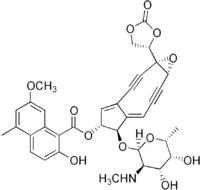Neocarzinostatin
 |
|
 |
|
| Names | |
|---|---|
|
IUPAC name
(1aS,5R,6R,6aE)-6-{[(2R,3R,4R,5R,6R)-4,5-Dihydroxy-6-methyl-3-(methylamino)tetrahydro-2H-pyran-2-yl]oxy}-1a-(2-oxo-1,3-dioxolan-4-yl)-2,3,8,9-tetradehydro-1a,5,6,9a-tetrahydrocyclopenta[5,6]cyclonona[1,2-b]oxiren-5-yl 2-hydroxy-7-methoxy-5-methyl-1-naphthoate
|
|
| Identifiers | |
|
|
|
3D model (JSmol)
|
|
| ChemSpider | |
|
PubChem CID
|
|
|
|
|
|
| Properties | |
| C35H33NO12 | |
| Molar mass | 659.64 g/mol |
| Pharmacology | |
| Pharmacokinetics: | |
| Renal | |
|
Except where otherwise noted, data are given for materials in their standard state (at 25 °C [77 °F], 100 kPa).
|
|
|
|
|
| Infobox references | |
Neocarzinostatin (NCS) is a macromolecular chromoprotein enediyne antitumor antibiotic secreted by Streptomyces macromomyceticus.
It consists of two parts, a labile chromophore (the non-protein molecular entity shown at right) and a 113 amino acid protein to which the chromophore is tightly and non-covalently bound with high affinity (Kd ~ 10−10 M). The non-protein component is a very potent DNA-damaging agent; However it is extremely unstable and the role of the protein is to protect it and release it to the target DNA. Opening of the epoxide under reductive conditions present in cells creates favorable conditions for a Bergman cyclization, that leads to formation of benzyne, Followed by DNA strand cleavage. Another important member of the chromoprotein group of natural products is kedarcidin.
As a medicine it is among the most potent, and in Japan only it has been used against liver cancer clinically.
The biosynthesis of Neocarzinostatin Chromophore takes place through a convergence of the activities of a gene cluster, which includes, two separate iterative type I polyketide synthase (PKS) and deoxy sugar biosynthetic pathways. The first type I PKS gene NcsE codes for the enediyne moiety. The second type I PKS gene NcsB codes for the naphthoic acid moiety. Additionally, a cluster of NcsC genes are responsible for coding enzymes for the synthesis of the deoxyamino sugar moiety of NCS chromophore. The biosynthesis of NCS Chromophore can be divided into three stages:
1.Synthesis of deoxyaminosugar moiety: This part is carried out by the enzymes encoded by a cluster of seven genes, named NcsC through Ncs6. Since, these enzymes have similarity to dNDP-D-mannose synthases, it has been proposed that, the synthesis starts from D-mannose-1-phosphate. Since the C-2 hydroxyl group (-OH) is ultimately eliminated, the possibility of having D-glucose-1-phosphate cannot also be ruled out. However, additional studies indicate that, D-mannose-1-phosphate is the more likely starting point.
...
Wikipedia
